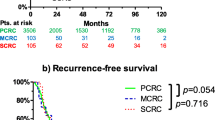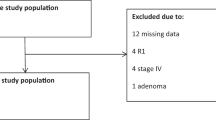Abstract
Purpose
The study was designed to examine the significance of colorectal metachronous carcinoma in a large cohort of patients.
Methods
Over a mean follow-up period of 10 years, the clinicopathological features, microsatellite instability (MSI) and clinical follow-up of 56 patients with metachronous colorectal carcinoma were analysed.
Results
The prevalence of metachronous colorectal carcinoma was 2.1 %. The metachronous colorectal carcinomas appeared between 7 and 246 months (mean = 66 months) after surgical resection of the index colorectal carcinomas. Thirty-six per cent (n = 20) of the metachronous carcinoma occurred more than 5 years after the operation of the index carcinoma. Of the 56 patients, 20 % (n = 11) of the metachronous colorectal carcinomas were mucinous adenocarcinoma. Cancers detected in the secondary operations (metachronous colorectal carcinomas), when compared with the primary index cancers, were smaller, showed higher proportions of mucinous adenocarcinoma and more often located in the proximal colon. Patients with metachronous colorectal cancers had higher prevalence of mucinous adenocarcinoma, loss of staining for MSI markers and better survival rates than other patients with colorectal cancers.
Conclusions
Patients with metachronous colorectal carcinomas have characteristic features, and attention to these features is important for better management of this group of cancer.

Similar content being viewed by others
References
Bekdash B, Harris S, Broughton CI, Caffarey SM, Marks CG (1997) Outcome after multiple colorectal tumours. Br J Surg 84(10):1442–1444
Chen HS, Sheen-Chen SM (2000) Synchronous and “early” metachronous colorectal adenocarcinoma: analysis of prognosis and current trends. Dis Colon Rectum 43(8):1093–1099
Wang HZ, Huang XF, Wang Y, Ji JF, Gu J (2004) Clinical features, diagnosis, treatment and prognosis of multiple primary colorectal carcinoma. World J Gastroenterol 10(14):2136–2139
Velayos FS, Lee SH, Qiu H, Dykes S, Yiu R, Terdiman JP, Garcia-Aguilar J (2005) The mechanism of microsatellite instability is different in synchronous and metachronous colorectal cancer. J Gastrointest Surg 9(3):329–335
Lan YT, Lin JK, Li AF, Lin TC, Chen WS, Jiang JK, Yang SH, Wang HS, Chang SC (2005) Metachronous colorectal cancer: necessity of post-operative colonoscopic surveillance. Int J Colorectal Dis 20(2):121–125
Park IJ, Yu CS, Kim HC, Jung YH, Han KR, Kim JC (2006) Metachronous colorectal cancer. Colorectal Dis 8(4):323–327
Ballesté B, Bessa X, Piñol V, Castellví-Bel S, Castells A, Alenda C, Paya A, Jover R, Xicola RM, Pons E, Llor X, Cordero C, Fernandez-Bañares F, de Castro L, Reñé JM, Andreu M, Gastrointestinal Oncology Group of the Spanish Gastroenterological Association (2007) Detection of metachronous neoplasms in colorectal cancer patients: identification of risk factors. Dis Colon Rectum 50(7):971–980
Yoon JW, Lee SH, Ahn BK, Baek SU (2008) Clinical characteristics of multiple primary colorectal cancers. Cancer Res Treat 40(2):71–74
Tziris N, Dokmetzioglou J, Giannoulis K, Kesisoglou I, Sapalidis K, Kotidis E, Gambros O (2008) Synchronous and metachronous adenocarcinomas of the large intestine. Hippokratia 12(3):150–152
Hollington P, Tiong L, Young G (2011) Timing and detection of metachronous colorectal cancer. ANZ J Surg 81(4):272–274
Hamilton SR, Vogelstein B, Kudo S, Riboli E, Nakamura S, Hainaut P (2000) In: Hamilton SR, Aaltonen LA (eds) Carcinoma of the colon and rectum. WHO classification of tumors: pathology and genetics of tumors of digestive system. IARC Press, Lyon, pp 105–119
Umar A, Boland CR, Terdiman JP, Syngal S, de la Chapelle A, Rüschoff J, Fishel R, Lindor NM, Burgart LJ, Hamelin R, Hamilton SR, Hiatt RA, Jass J, Lindblom A, Lynch HT, Peltomaki P, Ramsey SD, Rodriguez-Bigas MA, Vasen HF, Hawk ET, Barrett JC, Freedman AN, Srivastava S (2004) Revised Bethesda Guidelines for hereditary nonpolyposis colorectal cancer (Lynch syndrome) and microsatellite instability. J Natl Cancer Inst 96(4):261–268
Pritchard CC, Grady WM (2011) Colorectal cancer molecular biology moves into clinical practice. Gut 60(1):116–129
Geiersbach KB, Samowitz WS (2011) Microsatellite instability and colorectal cancer. Arch Pathol Lab Med 135(10):1269–1277
Lam AK, Carmichael R, Gertraud Buettner P, Gopalan V, Ho YH, Siu S (2011) Clinicopathological significance of synchronous carcinoma in colorectal cancer. Am J Surg 202(1):39–44
Lam AKY, Ong K, Ho YH (2006) Colorectal mucinous adenocarcinoma: the clinicopathologic features and significance of p16 and p53 Expression. Dis Colon Rectum 49(9):175–183
Gopalan V, Smith RA, Ho YH, Lam AK (2011) Signet-ring cell carcinoma of colorectum—current perspectives and molecular biology. Int J Colorectal Dis 26(2):127–133
Leopoldo S, Lorena B, Cinzia A, Gabriella DC, Angela Luciana B, Renato C, Antonio M, Carlo S, Cristina P, Stefano C, Maurizio T, Luigi R, Cesare B (2008) Two subtypes of mucinous adenocarcinoma of the colorectum: clinicopathological andgenetic features. Ann Surg Oncol 15(5):1429–39
Gopalan V, Smith RA, Nassiri MR, Yasuda K, Salajegheh A, Kim SY, Ho YH, Weinstein S, Tang JC, Lam AK (2010) GAEC1 and colorectal cancer: a study of the relationships between a novel oncogene and clinicopathologic features. Hum Pathol 41(7):1009–1015
Lam AK, Ong K, Ho YH (2008) Aurora kinase expression in colorectal adenocarcinoma: correlations with clinicopathological features, p16 expression, and telomerase activity. Hum Pathol 39(4):599–604
Saleh S, Lam AK, Ho YH (2008) Real-time PCR quantification of human telomerase reverse transcriptase (hTERT) in colorectal cancer. Pathology 40(1):25–30
Bülow S, Svendsen LB, Mellemgaard A (1990) Metachronous colorectal carcinoma. Br J Surg 77(5):502–505
Sargent DJ, Marsoni S, Monges G, Thibodeau SN, Labianca R, Hamilton SR, French AJ, Kabat B, Foster NR, Torri V, Ribic C, Grothey A, Moore M, Zaniboni A, Seitz JF, Sinicrope F, Gallinger S (2010) Defective mismatch repair as a predictive marker for lack of efficacy of fluorouracil-based adjuvant therapy in colon cancer. J Clin Oncol 28(20):3219–3226
Author information
Authors and Affiliations
Corresponding author
Rights and permissions
About this article
Cite this article
Lam, A.KY., Gopalan, V., Carmichael, R. et al. Metachronous carcinomas in colorectum and its clinicopathological significance. Int J Colorectal Dis 27, 1303–1310 (2012). https://doi.org/10.1007/s00384-012-1474-y
Accepted:
Published:
Issue Date:
DOI: https://doi.org/10.1007/s00384-012-1474-y




